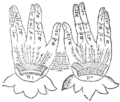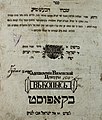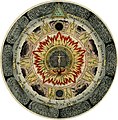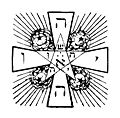Kabbalah
Jump to navigation
Jump to search
English: Kabbalah (Hebrew קַבָּלָה "tradition/reception", Standard Hebrew Qabbala, Tiberian Hebrew Qabbālāh; also written variously as Cabala, Cabalah, Cabbala, Cabbalah, Kabala, Kabalah, Kabbala, Qabala, Qabalah, Kaballah) is an interpretation (exegesis, hermeneutic) key, "soul" of the Torah (Hebrew Bible), or the religious mystical system in Judaism claiming an insight into divine nature. It also led to separate non-Jewish syncretic traditions of esotericism: religious Christian Cabala (often spelled "Cabala" in English, to distinguish it) and occult Hermetic Qabalah (usually spelled "Qabalah" in English, to distinguish it).
Deutsch: Kabbala
Italiano: Cabala
Main collection: Category:Kabbalah (كتاب قبالة وترجمة لغة العبرية إلى الغة العربية )
Early Jewish mysticism in Antiquity
[edit]Category:Early Jewish mysticism
-
Enoch scroll from the Dead Sea Scrolls c.200-150 BCE, a focus of early apocalyptic mysticism
-
Genesis in Jewish art. Creation verses were a focus of early Rabbinic Jewish mysticism
-
Ezekiel's vision, Christian depiction. The Divine Merkabah Chariot was a focus of early Jewish mysticism
-
Hekhalot Heavenly Palaces texts describe a metaphorical Jerusalem Temple
-
Grave of Rabbi Akiva c.40–137 CE, a figure in early Rabbinic mysticism
Kabbalistic theosophy-doctrine in Judaism
[edit]See also Kabbalah Tree of life
-
The 10 Sephirot Divine emanations, including Daat; the foundation of medieval Kabbalah
-
Creation of the Spiritual Worlds from the Ein Sof. In Lurianic Kabbalah, within the "empty space"
-
The Sephirot in the Human soul and body, Adam Kadmon containing the future souls of mankind
-
Torah script. Jewish Kabbalists read the Hebrew text as Divine symbols
-
Kabbalistic story by Nachman of Breslav. The Shekhinah Presence is the feminine aspect of God
-
Shaar Hagilgulim on reincarnation in Judaism; a new tenet of Kabbalah, later explained by Luria
-
In Lurianic Kabbalah, physical objects contain sparks of holiness redeemed by man
Meditative-ecstatic Kabbalah in Judaism
[edit]-
Hebrew names of God meditations
-
Priestly blessing Kabbalistic meditation
-
A 72x3 Name of God in Jewish meditation. Used magically in non-Jewish occult Qabalah
Practical-magical Kabbalah in Judaism
[edit]-
Raziel HaMalakh, medieval Jewish practical Kabbalah grimoire
-
15th century Kabbalistic Jewish amulet
-
Plaque to Seckel Löb Wormser, 1768-1847, a Baal Shem practical healer in Germany
Jewish Kabbalah texts
[edit]-
Medieval Nachmanides commentary on the Torah, 15th century copy
-
The Zohar, main book of Kabbalah. Disseminated late 1200s, first printing 1550s
-
Latin translation of Shaarei Ora by medieval Joseph Gikatilla
-
Sefer HaTemunah, medieval theoretical text
-
Sefer hakavanot, from 16th century students of Isaac Luria
-
Chesed Le'Avraham by 17th century Moroccan Abraham Azulai
-
Yalkut Hadash, 1648 anthology from Poland
-
Menorat zahav, early Hasidic Kabbalah, print collection Poland 1902
-
Kabbalistic prayer book
-
Scholem collection Jewish mysticism archive in the National Library of Israel, Jerusalem
Jewish Kabbalists
[edit]-
Artistic image of Nachmanides, initial medieval leader of Kabbalah
-
Artistic image of Moses de Leon, academic medieval source of Zohar
-
Abraham Abulafia, medieval ecstatic-meditative Kabbalist
-
Joseph Karo, 16th century legalist and mystic
-
Naphtali Cohen, 17th century Russo-German Kabbalist
-
Vilna Gaon, 18th century Lithuanian sage
-
Moshe Teitelbaum, 19th century Hasidic Rebbe
-
Yosef Hayyim, 19th century Iraqi sage
-
Yehuda Ashlag, 20th century Israeli Kabbalist
Jewish Kabbalah locations
[edit]Category:Kabbalistic synagogues and Category:Tombs and graves of Kabbalists
-
Tomb of Shimon bar Yochai
-
Museum-synagogue in Girona, Spain, an early Kabbalah centre
-
Grave of Moshe Cordovero, Safed
-
Grave of Isaac Luria, Safed, father of modern Jewish Kabbalah
-
Ari Ashkenazi Synagogue, Safed
-
Grave of Maharal, Prague
-
Ramhal synagogue, Acre, Israel
-
Grave of Baal Shem Tov, founder of Hasidism, Ukraine
-
Monument to Vilna Gaon on site of former Vilna synagogue, Lithuania
-
Beit El Synagogue, Jerusalem, yeshiva of the Kabbalists
Sabbatean Jewish mystical heresy
[edit]-
Sabbatai Zevi, 17th century messiah claimant
-
Nathan of Gaza, Sabbatai's prophet
-
"Sabbatai Zevi enthroned", published Amsterdam 1666
-
Jacob Frank, 18th century Sabbatean successor, at his death bed
-
Sabbatean work, printed Berlin 1713
-
Jonathan Eybeschutz, mainstream 1700s Rabbi, accused by Jacob Emden of Sabbateanism
Hasidic Jewish popularisation of Kabbalah
[edit]-
1961 Israel stamp of the Baal Shem Tov, 18th century founder of Hasidism
-
Besht synagogue, Ukraine. Hasidism taught Divinity in everything and closeness to everyone
-
Cleaving to the Tzadik Hasidic leader popularised Kabbalah as a social mysticism
-
Sculpture of the Hasidic movement on the Knesset Menorah
-
Shivhei HaBesht, first publication of stories about Hasidic leaders, 1815
-
Hasidic prayer painting
-
Martin Buber, German Jewish philosopher and founder of Neo-Hasidism
Jewish customs from Kabbalah
[edit]See also Category:Jewish law and rituals
-
Lekha Dodi song for welcoming of the Shabbat
-
Tikun Leil Shavuot, text for reading though the night of Shavuot
Jewish Kabbalistic messianism
[edit]-
Kabbalist graves in Safed, Galilee. Its 1500s Jewish mystics turned Kabbalah into a messianic doctrine
-
Stylized signature of Solomon Molcho, Kabbalistic Messiah claimant, early 1500s
-
Sabbatean antinomian Messiah Shabbatai Tzvi as a prisoner of the Turks in Abydos, 1660s
-
The "letter from Heaven" of Hasidic Rebbe Nachman of Breslav
-
Messianic posters for Hasidic Rebbe of Chabad-Lubavitch
Academics of Jewish mysticism
[edit]Category:Academics and researchers of Jewish mysticism
-
Moshe Idel, proposed revisions of Scholem, Hebrew University
-
Rachel Elior, Hebrew University
-
Norman Lamm, American Modern Orthodox leader and scholar of Hasidic-Mitnagdic Kabbalah
Modern teachers of Jewish mysticism
[edit]-
Michael Laitman, founder of Bnei Baruch, Yehuda Ashlag school of Kabbalah
-
Talmudist and Hasidic Kabbalah teacher Adin Steinsaltz
-
Neo-Hasidic teacher Zalman Schachter-Shalomi with American Hindu teacher Ram Dass
Christian Cabala
[edit]-
De Harmonia Mundi totius (Harmony of the World) by Venetian Franciscan Francesco Giorgi, 1525
-
De Arte Cabalistica (The Cabalistic Art) by Johann Reuchlin, 1530
-
Christian adaption of the 10 Sephirot by Heinrich Khunrath, 1595
-
Athanasius Kircher's Oedipus Aegyptiacus, Christian eschatology based on Hebrew Cabala
-
Kabbalistic Tree of Life by Kircher with the Jewish commandments
-
Sefirotic diagrams from Cabala Denudata (Cabala Unveiled) by Knorr von Rosenroth, 1600s
Christian Cabalists
[edit]-
Pico della Mirandola, Italian Renaissance philosopher and early Christian Kabbalist
-
Johann Reuchlin, Renaissance German humanist and scholar of Greek and Hebrew
-
Athanasius Kircher, early-modern Jesuit and polymath
-
Princess Antonia of Württemberg, Germany, early-modern Christian Kabbalist
-
Christian Knorr von Rosenroth, early-modern German Hebraist
-
Personal design pentagrammaton symbol of early-modern German mystic Jakob Böhme, influenced by Cabala
Occult Hermetic Qabalah
[edit]-
Renaissance Cabalistic magic from Three Books of Occult Philosophy by Cornelius Agrippa
-
Personal Cabalistic symbol designed by Elizabeth I of England's Christian occultist John Dee
-
Christian Cabala diagram of the 72 Jewish Names of God, used magically in Hermetic Qabalah
-
Hermetic syncretism of Cabala, Alchemy and Astrology in a 1654 German depiction
-
17th century magical evocation Pentacles from the Key of Solomon
-
Cabalistic angels in The Magus ceremonial magic Grimoire by Francis Barrett, 1801
The Tree of Life in Occult Qabalism
[edit]Category:Tree of life (Kabbalah)
-
Qabalistic Tree of Life with Egyptian associations
-
The Major Arcana Tarot cards in a Qabalistic Tree of Life
-
Magician Qabalistic Tarot card with other religions associations
-
Qabalistic astrology Tree of life with occult colours of Aleister Crowley
Occult Hermetic Qabalists
[edit]Category:Cabalists. See also Category:Occultists and Category:Esotericism
-
Renaissance German occultist and theologian Cornelius Agrippa
-
Heinrich Khunrath, 16th century German Lutheran physician, occultist and alchemist
-
Robert Fludd, early-modern English occult philosopher, physician and mathematician
-
A Rosicrucian symbol. Rosicrucian groups studied occultism from the Enlightenment onwards
-
Eliphas Levi, 19th century French author and revivalist of magic
-
Max Theon, Polish Jewish occultist who founded the Cosmic Movement in Algeria
-
MacGregor Mathers, a founder of the 19th-20th centuries Golden Dawn British magic society
-
Arthur Edward Waite, English scholarly occultist, author of The Holy Kabbalah
-
Aleister Crowley, English founder of Thelema new religious movement, incorporating occult Qabalah elements
Modern teachers of non-Jewish Qabalah
[edit]Category:Cabalists. See also Category:Occultists and Category:Esotericism
-
Paul Foster Case, American Qabalist founder of the esoteric occult school Builders of the Adytum
-
Grave of Dion Fortune, 1890–1946, English founder of the esoteric occult school Fraternity of the Inner Light
-
Samael Aun Weor, Colombian Hermetic Qabalist founder of the Universal Christian Gnostic Movement
Kabbalah in popular culture
[edit]See also Category:Jewish mythology
-
Kabbalist in 1641 woodcut of occupations
-
The Golem legend. The Maharal of Prague creating a man-like being
-
The Dybbuk Yiddish play about a deceased soul spirit possession
-
Jewish pilgrimage to Kabbalistic tombs
-
Kabbalistic Tree of Life in Jewish Museum, Amsterdam
-
1947 drawing of Scholem "Baal HaZohar" (Master of the Zohar)
-
The Aleph, short story by Jorge Luis Borges, influenced by Kabbalah
-
Kabbalist on Knesset Menorah, Jerusalem, in front of 10 sephirot circles and Hebrew letters
-
Kabbalah Centre organisation in New York City
-
Jewish folk-culture Kabbalistic jewellery
-
Cabala names in Magic. Non-Jewish Cabalism is part of Western Occult and Esotericism, different from Jewish Kabbalah
-
Non-Jewish magical view of symbols used by the Hebrews from the Cabala and Talmud






















































































































